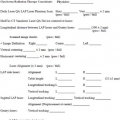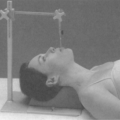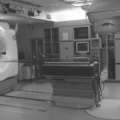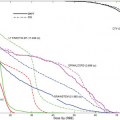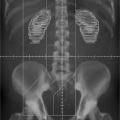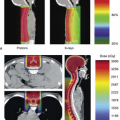Tolerance of Normal Tissue to Therapeutic Radiation
Bahman Emami
Eric Kielhorn
Introduction
Radiation therapy is an integral part of the treatment of patients inflicted with cancer. It is estimated that over 60% of patients with cancer will have radiotherapy as part of their total course of treatment (1). Radiation therapy affects both tumor cells and uninvolved normal cells; the former to the benefit and the later to the detriment of patients. With the goal of achieving uncomplicated local regional control of cancer, balancing between the two is both an art and a science of radiation oncology. Unfortunately, after over 100 years of practicing radiation oncology and in spite of much recent progress, knowledge on either of the two is far from perfect.
From a historical point of view, the first formal attempt to address at least one of the goals, namely normal tissue tolerance to radiation, was carried out by Rubin and Cassarett (2). Even though this publication was a collection of anecdotal reports, it has served radiation oncologists as a raw reference to build on their own experience. The decade of the 1980s was a quantum leap of progress in the field of radiation oncology. With the monumental work of researchers on four National Cancer Institute multi-institutional contracts, the science and practice of radiation oncology changed from a two-dimensional (2D) to a three-dimensional (3D)/volumetric process (3). During the work on these contracts, it became apparent to the clinicians that information on the tumoricidal doses of radiation as well as normal tissue complication doses, especially on partial volumes, is mostly empirical and totally inadequate. A committee was formed to address a part of this dilemma by comprehensively reviewing the available published data. In the process of this review by the committee, it became clear that much of the data is nonexistent and they would have to rely on the collective experience of eight clinicians from major institutions in the United States. Moreover, in order to shed some light on the volumetric aspect of these issues, it was decided that organs be divided into one-third, two-thirds, and whole organ volumes. In spite of the clear indication in the manuscript on the paucity of solid experimental/prospectively driven data, this publication, so-called Emami’s paper, has gained much popularity. The main goal of this publication was to address a clinical need based on available information up to that time and points to the fact that there is a need for extensive and comprehensive research in this area. Obvious limitations of the publication were as follows: (1) It was a literature review up to 1991. (2) It completely pre-dated the 3D-CRT-IMRT-IGRT era. Even at that time dose-volume histograms were not in routine clinical use. (3) It was a tabulation of the estimates for three of the aforementioned arbitrary volumes. (4) It was only for external beam radiation with conventional fractionation. (5) Only one severe complication was chosen as an endpoint.
Over the last two decades, since the publication of “Emami’s paper” the practice of radiation oncology has been completely revolutionized:
Multidisciplinary management of cancer has become the standard of care.
Choice of an endpoint for complication analysis and modeling has significantly altered.
There has been a major revolutionary change in technology:
CT simulation has become routine along with the fusion of other modalities such as MRI, PET, and 4DCT.
3D-CRT/IMRT/IGRT has become standard with the array of evaluation tools.
As a result, dose distributions have become very complex and as of recent, the fourth dimension, namely time, has also been added to this complexity. Multiplicity and complexities of factors affecting radiation including normal tissue complications have made it impossible to have actual data for every clinical situation facing practicing radiation oncologists. Therefore, there is a need to have reasonable predictive models for plan evaluation, to improve tumor control, and to predict and hopefully prevent normal tissue injury. Optimally, databases on biophysical models should be used in summarizing complicated dose-volume data to help describe clinical outcomes and ultimately aid in the prediction of clinical toxicity.
During the last two decades, a vast amount of published information has become available to address the relationship between dosimetric parameters and the clinical outcomes of normal tissues. Because of different analytic methodologies, calculation methods, endpoints, grading schemes, etc., the data is noisy and sifting through these data for practicing radiation oncologists is a nearly impossible task. Realizing this difficulty and the obvious
need for a simplistic format, a group of physicians and researchers were formed with the name “The Quantitative Analysis of Normal Tissue Effects in the Clinic (QUANTEC).” The first goal was to review the available literature of the last 18 years on volumetric/dosimetric information of normal tissue complication and provide a simple set of data to be used by the busy community practitioners of radiation oncology, physicists, and dosimetrists. The second goal of the QUANTEC group was to provide reliable predictive models on relationships between dose-volume parameters and the normal tissue complications to be utilized during the planning of radiation oncology. The result of several years of work by this group has recently been published (4,5,6,7,8,9,10,11,12,13,14,15,16,17,18,19,20,21,22,23,24,25,26,27). Although these publications contain a comprehensive review of published information and can be a guide for future research on this issue, they still have many shortcomings mainly due to the basic complexity of the subject. This shortcoming has been clearly indicated in the QUANTEC publication and the need for much more data in the future has been emphasized. However, the presented data in the publication is still cumbersome and lacks the “user-friendliness,” which is required to be used in the day-to-day practice of a busy community clinician. As shown in Table 22.1 there are numerous factors that affect the radiation-induced complications of normal tissues on any given clinical situation. Thus, the experience
and judgment of the clinician still plays the most important role in treating patients. As for predictive models, the problem lies in finding a reasonable model, acquiring sufficient data, and applying the statistical methods properly. So far, in spite of major efforts, there is no model that has been demonstrated to predict radiation responses with sufficient accuracy for widespread clinical use. Most of the modeling at this point is still phenomenological and “descriptive” rather than predictive. The development of reliable and user-friendly predictive models is quite unlikely in the near future.
need for a simplistic format, a group of physicians and researchers were formed with the name “The Quantitative Analysis of Normal Tissue Effects in the Clinic (QUANTEC).” The first goal was to review the available literature of the last 18 years on volumetric/dosimetric information of normal tissue complication and provide a simple set of data to be used by the busy community practitioners of radiation oncology, physicists, and dosimetrists. The second goal of the QUANTEC group was to provide reliable predictive models on relationships between dose-volume parameters and the normal tissue complications to be utilized during the planning of radiation oncology. The result of several years of work by this group has recently been published (4,5,6,7,8,9,10,11,12,13,14,15,16,17,18,19,20,21,22,23,24,25,26,27). Although these publications contain a comprehensive review of published information and can be a guide for future research on this issue, they still have many shortcomings mainly due to the basic complexity of the subject. This shortcoming has been clearly indicated in the QUANTEC publication and the need for much more data in the future has been emphasized. However, the presented data in the publication is still cumbersome and lacks the “user-friendliness,” which is required to be used in the day-to-day practice of a busy community clinician. As shown in Table 22.1 there are numerous factors that affect the radiation-induced complications of normal tissues on any given clinical situation. Thus, the experience
and judgment of the clinician still plays the most important role in treating patients. As for predictive models, the problem lies in finding a reasonable model, acquiring sufficient data, and applying the statistical methods properly. So far, in spite of major efforts, there is no model that has been demonstrated to predict radiation responses with sufficient accuracy for widespread clinical use. Most of the modeling at this point is still phenomenological and “descriptive” rather than predictive. The development of reliable and user-friendly predictive models is quite unlikely in the near future.
Table 22.1 Variables That Can Impact Normal Tissue Tolerance | ||||||||||||||||||||||||||||||||||||||||
|---|---|---|---|---|---|---|---|---|---|---|---|---|---|---|---|---|---|---|---|---|---|---|---|---|---|---|---|---|---|---|---|---|---|---|---|---|---|---|---|---|
| ||||||||||||||||||||||||||||||||||||||||
After reviewing the publication by the QUANTEC group, we attempt to provide the clinicians and the practitioners of radiation oncology a comprehensive but simpler, user-friendly set of data (Tables 22.2 and 22.3). It should be noted that the data is not intended to be extrapolated to pediatric patients. The data should be used only as a guide and does not substitute for a physician’s clinical judgment. We believe, as indicated in the original paper of “Emami et al.” and in the QUANTEC publication, that there is an urgent need for systematic research on this issue, which we hope will be forthcoming.
Word of Caution About BED
Recently, it has become popular (as in many sections of QUANTEC publication) to convert the dose-fractionation to a biological equivalent dose (BED) in order to compare various dosimetric parameters. A practical version of isoeffect formula based on the linear quadratic (LQ) model is:
The index of α/β is calculated based on information from cell survival curves that has been extrapolated and extended to human tumor and normal tissues by some computerized scientists. Unverified assignment of an α/β ratio and using it to calculate a normal tissue tolerance dose can be misleading or at least should be experimentally validated before being recommended for routine clinical use (7,9,10). The following are some basic facts based on current knowledge:
| Fact 1 | Dose/fractionation has significant impact on normal tissue complications, e.g., central nervous system (CNS) |
| Fact 2 | 1.8–2.0 Gy per fraction, five fractions per week, is considered standard in the United States |
| Fact 3 | In a majority of publications during last two decades an α/β ratio of 2 is used for CNS tissues (28,29) |
| Fact 4 | In the QUANTEC publication an α/β of 3 is used to calculate BED for CNS tissues (7,9) |
| Fact 5 | Using the power of IMRT technology, one can have any dose/fraction as a constraint for tissues such as CNS |
The following example depicts the basic fallacies of using BED, calculated from the above formula in clinics.
Example:
| Gy dose/fractions | Dose/fraction (Gy) | α/β for brain tissue | BED |
|---|---|---|---|
| 60 Gy/30 Fra | 2 | 1 | 180 |
| 60 Gy/30 Fra | 2 | 2 | 120 |
| 60 Gy/30 Fra | 2 | 3 | 100 |
If we arbitrarily choose 1 Gy/fraction/day of brain tissue, then the conversion of BED to dose/fractionation of 1 Gy/day:
| BED | Dose/fraction (Gy) | α/β | Calculated total dose from formula (Gy) |
|---|---|---|---|
| 180 | 1 | 1 | 90 |
| 120 | 1 | 2 | 80 |
| 100 | 1 | 3 | 75 |
| 180 | 3 | 1 | 45 |
| 120 | 3 | 2 | 48 |
| 100 | 3 | 3 | 51 |
In the authors’ limited informal survey, no radiation oncologists would use 90 Gy at 1 Gy/day or 51 Gy at 3 Gy/day (despite being the same BED as 60 Gy in 30 fractions using an α/β of 1), thus limiting the applicability of BED for routine clinical use.
The following descriptive paragraphs of Tables 22.2 and 22.3 are presented as general guidelines.
Standard Fractionation
Central Nervous System
Brain
Radiation necrosis of the brain typically occurs 3 months to several years after radiotherapy (median 1–2 years) (3,7). The original Emami publication estimated a 5% risk of radionecrosis at 5 years with a dose of 60 Gy to one-third of the brain with standard fractionation (3). More recently,
QUANTEC conducted an extensive review of the modern literature and published new dose constraints for the brain (6,7). The review was based on a heterogeneous group of studies with varied dose and fractionation schemes. Studies were compared using the BED with an α/β ratio of 3. A dose–response relationship was found to exist. For standard fractionation, the incidence of radionecrosis appears to be <3% for a dose of <60 Gy. The incidence increases to 5% with a dose of 72 Gy and 10% with a dose of 90 Gy. However, these doses were based on studies with widely varying parameters (target volumes, sample size, brain region, etc.). It should be noted that an α/β ratio of 3 is greater than the values frequently used in the literature and caution should be used when converting to BED (see above discussion). In our practice, we strive to achieve very homogeneous dose distributions with a Dmax (point dose) ≤ 65 Gy with only rare occurrences of symptomatic radiation necrosis.
QUANTEC conducted an extensive review of the modern literature and published new dose constraints for the brain (6,7). The review was based on a heterogeneous group of studies with varied dose and fractionation schemes. Studies were compared using the BED with an α/β ratio of 3. A dose–response relationship was found to exist. For standard fractionation, the incidence of radionecrosis appears to be <3% for a dose of <60 Gy. The incidence increases to 5% with a dose of 72 Gy and 10% with a dose of 90 Gy. However, these doses were based on studies with widely varying parameters (target volumes, sample size, brain region, etc.). It should be noted that an α/β ratio of 3 is greater than the values frequently used in the literature and caution should be used when converting to BED (see above discussion). In our practice, we strive to achieve very homogeneous dose distributions with a Dmax (point dose) ≤ 65 Gy with only rare occurrences of symptomatic radiation necrosis.
Table 22.2 Normal Tissue Tolerance for Standard Fractionation | ||||||||||||||||||||||||||||||||||||||||||||||||||||||||||||||||||||||||||||||||||||||||||||||||||||||||||||||||||||||||||||||||||||||||||||||||||||||||||||||||||||||||||||||||||||||||||||||||||||||||||||||||||||||||||||||||||||||||||||||||||||||||||||||||||||||||||||||||||||
|---|---|---|---|---|---|---|---|---|---|---|---|---|---|---|---|---|---|---|---|---|---|---|---|---|---|---|---|---|---|---|---|---|---|---|---|---|---|---|---|---|---|---|---|---|---|---|---|---|---|---|---|---|---|---|---|---|---|---|---|---|---|---|---|---|---|---|---|---|---|---|---|---|---|---|---|---|---|---|---|---|---|---|---|---|---|---|---|---|---|---|---|---|---|---|---|---|---|---|---|---|---|---|---|---|---|---|---|---|---|---|---|---|---|---|---|---|---|---|---|---|---|---|---|---|---|---|---|---|---|---|---|---|---|---|---|---|---|---|---|---|---|---|---|---|---|---|---|---|---|---|---|---|---|---|---|---|---|---|---|---|---|---|---|---|---|---|---|---|---|---|---|---|---|---|---|---|---|---|---|---|---|---|---|---|---|---|---|---|---|---|---|---|---|---|---|---|---|---|---|---|---|---|---|---|---|---|---|---|---|---|---|---|---|---|---|---|---|---|---|---|---|---|---|---|---|---|---|---|---|---|---|---|---|---|---|---|---|---|---|---|---|---|---|---|---|---|---|---|---|---|---|---|---|---|---|---|---|---|---|---|---|---|---|---|---|---|---|---|---|---|---|---|---|---|---|---|
| ||||||||||||||||||||||||||||||||||||||||||||||||||||||||||||||||||||||||||||||||||||||||||||||||||||||||||||||||||||||||||||||||||||||||||||||||||||||||||||||||||||||||||||||||||||||||||||||||||||||||||||||||||||||||||||||||||||||||||||||||||||||||||||||||||||||||||||||||||||
Table 22.3 Mostly Unvalidated Normal Tissue Dose Constraints for SBRT | ||||||||||||||||||||||||||||||||||||||||||||||||||||||||||||||||||||||||||||||||||||||||||||||||||||||||||||||||||||||||||||||||||||||||||||||||||||||||||||||||||||||||||||||||||||||||||||||||||||||||||||||||||||||||||||||||||||||||||||||||||||||||||||||||||||||||||||||||||||||||||||||||||||||||||||||||||||||||||||||||||||||||||||||||||||||||||||||||||||||||||||||||||||||||||||||||||||||||||||||||||||||||||||||||||||||||||||||||||||||||||||||||||
|---|---|---|---|---|---|---|---|---|---|---|---|---|---|---|---|---|---|---|---|---|---|---|---|---|---|---|---|---|---|---|---|---|---|---|---|---|---|---|---|---|---|---|---|---|---|---|---|---|---|---|---|---|---|---|---|---|---|---|---|---|---|---|---|---|---|---|---|---|---|---|---|---|---|---|---|---|---|---|---|---|---|---|---|---|---|---|---|---|---|---|---|---|---|---|---|---|---|---|---|---|---|---|---|---|---|---|---|---|---|---|---|---|---|---|---|---|---|---|---|---|---|---|---|---|---|---|---|---|---|---|---|---|---|---|---|---|---|---|---|---|---|---|---|---|---|---|---|---|---|---|---|---|---|---|---|---|---|---|---|---|---|---|---|---|---|---|---|---|---|---|---|---|---|---|---|---|---|---|---|---|---|---|---|---|---|---|---|---|---|---|---|---|---|---|---|---|---|---|---|---|---|---|---|---|---|---|---|---|---|---|---|---|---|---|---|---|---|---|---|---|---|---|---|---|---|---|---|---|---|---|---|---|---|---|---|---|---|---|---|---|---|---|---|---|---|---|---|---|---|---|---|---|---|---|---|---|---|---|---|---|---|---|---|---|---|---|---|---|---|---|---|---|---|---|---|---|---|---|---|---|---|---|---|---|---|---|---|---|---|---|---|---|---|---|---|---|---|---|---|---|---|---|---|---|---|---|---|---|---|---|---|---|---|---|---|---|---|---|---|---|---|---|---|---|---|---|---|---|---|---|---|---|---|---|---|---|---|---|---|---|---|---|---|---|---|---|---|---|---|---|---|---|---|---|---|---|---|---|---|---|---|---|---|---|---|---|---|---|---|---|---|---|---|---|---|---|---|---|---|---|---|---|---|---|---|---|---|---|---|---|---|---|---|---|---|---|---|---|---|---|---|---|---|---|---|---|---|---|---|---|---|---|---|---|---|---|---|---|---|---|---|---|---|---|---|---|---|---|---|---|---|---|---|---|---|---|---|---|---|---|---|---|---|---|---|---|---|---|---|---|
| ||||||||||||||||||||||||||||||||||||||||||||||||||||||||||||||||||||||||||||||||||||||||||||||||||||||||||||||||||||||||||||||||||||||||||||||||||||||||||||||||||||||||||||||||||||||||||||||||||||||||||||||||||||||||||||||||||||||||||||||||||||||||||||||||||||||||||||||||||||||||||||||||||||||||||||||||||||||||||||||||||||||||||||||||||||||||||||||||||||||||||||||||||||||||||||||||||||||||||||||||||||||||||||||||||||||||||||||||||||||||||||||||||
Stay updated, free articles. Join our Telegram channel

Full access? Get Clinical Tree



